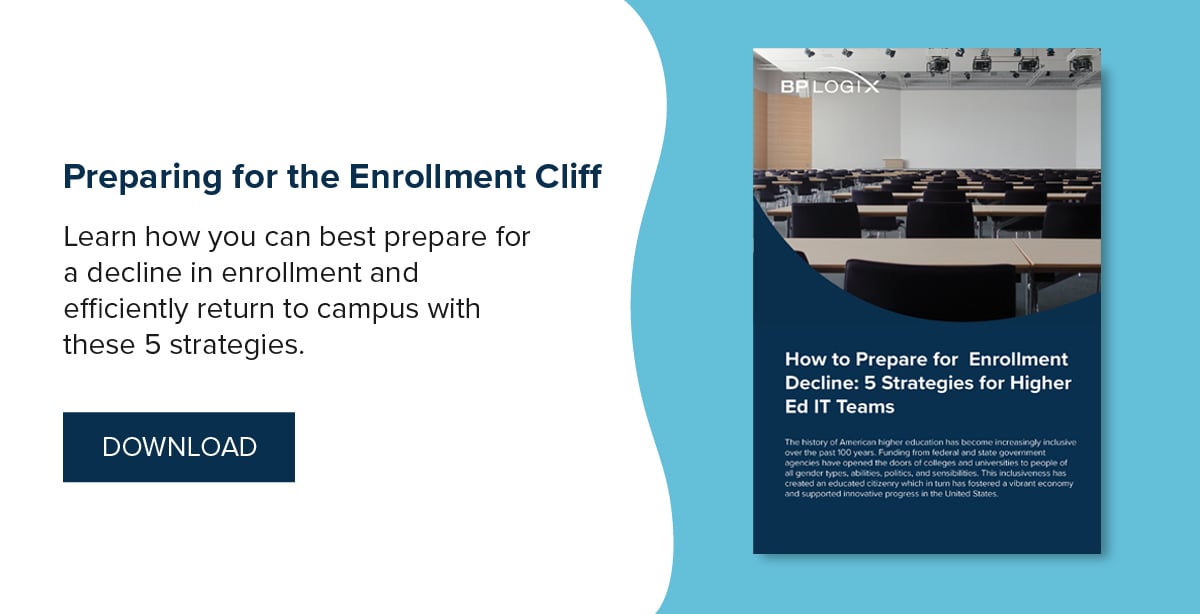Even before Coronavirus spread across the globe, colleges struggled with financial constraints and declining enrollment. Now, they’re scrambling to implement tools and reconfigure processes for remote learning.
Some universities have already issued statements that the upcoming fall 2020 semester will continue virtually, which could even last through spring 2021. Students are also seeking tuition refunds after switching to online classes, sparking class action lawsuits across the country.
Because of this, it’s more critical than ever that colleges and universities future-proof their academic and operational model. Nothing but uncertainty lies ahead, and those who are not prepared are likely to fall. But while America’s colleges and universities are sure to lose students in the short term, the pandemic’s obstacle is only temporary compared to the permanent structural forces affecting higher education.
Digital learning and declining enrollment for fall 2020
Education experts predict that college enrollment will be lower next semester and many colleges and universities are unsure if they will hold classes in-person in the fall.
According to The American Council on Education, a higher education lobby group, on-campus college enrollment will fall by 15% in the upcoming fall semester. This would cost institutions nearly $23 billion in foregone revenue, which would force many campuses to close their doors. Likewise, schools that are able to remain physically open through the pandemic are expected to see a surge in enrollment once it’s safe for students to return to the classroom.
Many universities have already announced their on-campus operational plan to encourage student commitment and provide some assurance of what form their education will take. Some, like Boston University (BU), plan to reopen its residential campus for the fall semester, but other universities like California State University–Fullerton plan to start the fall term online.
Some universities are also attempting to lead prospective students to enroll in the fall, rather than defer for a year until the pandemic is under greater control. For example, Southern New Hampshire University (SNHU) is offering free tuition to all incoming freshmen who enroll in its campus-based programs next year and will reduce published tuition for all of the following years by 61%.
According to Lynn Pasquerella, President of the Association of the American Colleges and Universities, colleges are not sure what to expect. “There’s some certainty with respect to a decrease in the number of international students that’s already been in rapid decline with a 14% decrease over the past few years. And they’re worried that this current global pandemic that has spurred an economic recession is going to further catalyze a depression, making it difficult for parents to send their children to college. On the flip side, I think we will see enrollments in online programs rise quite a bit, driven by adult learners — many of whom have been recently laid off — looking to wait out the recession and use their time productively by skilling up.”
Virtual processes can combat shrinking college budgets
The shift to digital learning and online classrooms has forced colleges to refund on-campus expenses like housing, meal plans, gym memberships and more––resulting in huge financial deficits and struggling colleges. On top of this, schools are also expecting a decline in enrollment this fall.
Yet college leaders have more to worry about––even if campuses reopen this fall, there are worries that many students won't return for fall 2020 due to the recent economic downturn that’s left many unable to afford tuition. Even more, universities are forecasting steep enrollment drop-offs among international students who feel hesitant to study abroad so closely after a global pandemic. And for colleges that rely on international students, officials are bracing for international enrollment to drop by 25%, causing a loss of $70 million next year.
Plunging student enrollment will present different challenges for higher education organizations. Fewer students means less tuition, and much of funding at the state and federal levels relies on the number of students who show up and occupy seats. Even if students are enrolled digitally, they won’t be occupying dorms or purchasing meal plans, causing colleges to lose major sources of revenue.
It’s not just students who will be missing from campus––renting out property and real estate throughout the summer for things like conferences and freshman orientations, tickets for sports games and summer camps are also a big source of revenue and employment for institutions. We’re even at risk of losing college football and fall sports, leaving organizations faced with the decision to play in front of empty stands, which would eliminate ticket revenue and incur broadcast licensing fees.
During a recession, enrollment usually goes up as more and more look for safety during a time of high unemployment or look to re-sharpen their skills. Now, university officials are nervous that families whose personal finances have been hurt since they filled out financial-aid forms may decide college has become an unaffordable investment for the time being.
Following the mid-March college shut-down of campus, schools have announced hundreds of millions of dollars in losses. Universities project that a $14 billion federal aid package will not be enough to keep struggling schools afloat, and experts say this recession is just the beginning of hardship if schools cannot identify ways to persuade and convince students to return in the fall, despite colleges preparing to transition into entirely digital learning by the end of the semester.
Establish future-proof workflows and processes with BP Logix
Colleges and universities are turning more and more to digital workflow solutions that connect their students and employees. Now that students aren’t in dorms, faculty aren’t on campus and the entire world is working from home, there’s still a critical need for structure and process implementation.
While scale of technology may always be an issue, the approach to problem-solving can be addressed by schools of any size. Workflow can be the defining factor for schools being agile because it is foundational for how problems are solved, irrespective of the technology that’s used.
To implement smooth transitions and enable changes in structure, exchanging data from information systems and financial applications must be solidified and secure. This allows colleges to create clear views into student information and provides the ability to relocate employees so you can become extremely agile as the “new normal” begins to take shape.
In a normal environment, the reliance on paper forms and manual intervention for decision-making milestones might be tolerated. But with massive pressure to conserve money and be highly efficient during this time of great change, college management, admissions and IT teams have to pull together all these things into an integrated, rapidly moving set of workflows in record time. New workflows and processes require a variety of forms, documents, requests, and decisions to be made.
Many BP Logix higher education customers are already using Process Director to handle these types of issues. Schools like California State University Stanislaus and the University of North Carolina NRI cite their ability to be flexible and quickly develop new processes as major advantages of using Process Director’s workflow automation capabilities as core to their foundation.
Successfully adapt to remote learning and survive a dip in enrollment for the coming semester(s) by transforming your processes and workflows. Process Director delivers capabilities like workflow automation that enables higher education teams to use pre-configured templates to quickly enable remote learning and reduce enrollment decline.




